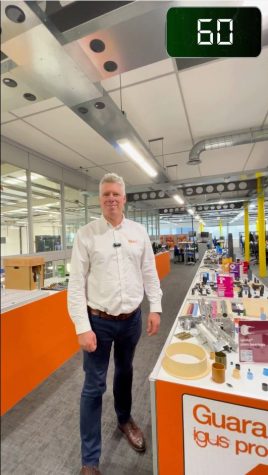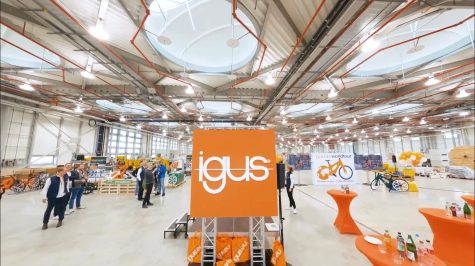For more information about delta robots visit igus.co.uk/delta.
Why do I need a robot?
Not every application requires a robot, but for those which involve hazardous or harmful tasks there should be a place for a human elsewhere without the danger of chemicals, heat, or heavy loads, for example. The most overlooked tasks are, however, those involving mundane or repetitive tasks such as picking and placing products before and/or after machining processes.
How to use a delta robot?
A delta robot can be used for standard small part applications such as picking from a conveyor or buffer table onto a stationary destination, or for painting, spraying, and repetitive work over a small area.
How safe is a robot?
Like any tool, a robot is as safe or dangerous as you use it. Cobots are said to not be wholly safe to interact with as one would with a human, and similarly non-collaborative robots are to be treated according to the power, hardware, and tools (or end-effectors) they feature. Helpful guides and contacts for maintaining safety with robots can be investigated via the many British robotics and automation organisations.
How to program a robot?
Robot programming is a task that specific engineers are trained for; for simple robots’ tasks, the programming is simpler and more generic than for robots performing tasks such as measuring and analysing a system with the use of many different axes. Various different programmes are available according to the complexity of the tasks, the number of degrees of freedom (DOF) the robot has, and whether or not the robot has autonomy in its tasks.
Why build a robot?
While most robots are available as full and ready-to-install machines, the igus® robots are available in modular forms ready to be built up and made bespoke to the application as well as systems ready to be added to a production line or work space.
Does igus® make plastic robots?
Our robots all feature polymers in their components, joints, and framework parts but these are all reinforced with metal components. The metals we use are either stainless steel, aluminium, or zinc.
What is delta robot on tour?
The delta robot tour was a 2019 mission that covered the length and breadth of the UK, demonstrating the delta robot and its key features during a pick and place task. The team, headed by our very own Vanessa achieved over 5000 miles, across 28 counties and 3 countries. We met a wide variety of customers from businesses with under 10 employees to international manufacturing companies. Spreading news about the automation division at igus® and its products to different companies in different areas of the UK was the objective, and it was surpassed time and time again.
The delta robot now lives back at our factory in Northampton and is visited by prospective customers each week for testing, demonstrations and general Low Cost Automation (LCA) visits.
Where is the delta robot used?
Today, one can find delta robots of varying sizes, payload capacities and speed competencies performing myriad tasks ranging from picking and placing baked goods in the food and beverage industry to transferring parts to and from a conveyor belt in the manufacturing industry. With the igus delta robot, the uses are endless.
If you have a unique application which seems be untypical of a delta robot, get in touch to discuss it and one of our engineers will be able to either advise how best to use a delta robot or suggest a suitable robot for your application.
How can I see a delta robot myself?
If you are interested in seeing the igus® delta robot, we would like to welcome you to the LCA Suite at our factory in Northampton. When you visit, you will be able to experience the size of the robot, its low and high working speeds, and the lean design of the igus® delta robot.
Get in touch with the LCA Product Manager Adam Sanjurgo: asanjurgo@igus.co.uk to find out more or arrange a visit to the LCA Suite in igus® factory.
What is the reach of the drylin® delta robot?
The drylin® delta robot can reach up to 360mm diameter when at 75mm height.
The larger version of the drylin® delta robot can reach up to 660mm diameter when at 180mm height.
What end effectors can be used with the drylin® delta robot?
The options are virtually endless when it comes to the end effectors used on the drylin® delta robot.
These can vary from electromagnets to suction cups, and mechanical grippers to 3D-printed gripping tools. All power and air can be carried to the end plate holding the end effector via a cable management system – we can supply this too!
What is the payload of a drylin delta robot?
The igus® delta robot can lift up to 5kg and press down up to 100N (10kg).
What is the range of a drylin® delta robot?
The drylin® delta robot can extend to a diameter of up to 360mm at a height of 75mm.
The larger version of the drylin® delta robot can reach a diameter of up to 660mm in 180mm height.
Which end effectors can be used for the drylin® delta robot?
With the end effectors used in the drylin® delta robot, the possibilities are almost unlimited. These can vary from electromagnets, suction cups and mechanical grippers up to 3D printed gripping tools. All energy and air can be directed via a cable management system to the end plate that holds the end effector, which we can also supply through the RBTX platform.
How precise is a drylin delta robot?
The accuracy of the drylin® delta robot is +/- 0.5mm.
How many picks per minute does the drylin® delta robot manage?
The drylin® delta robot can perform up to 60 picks per minute.





